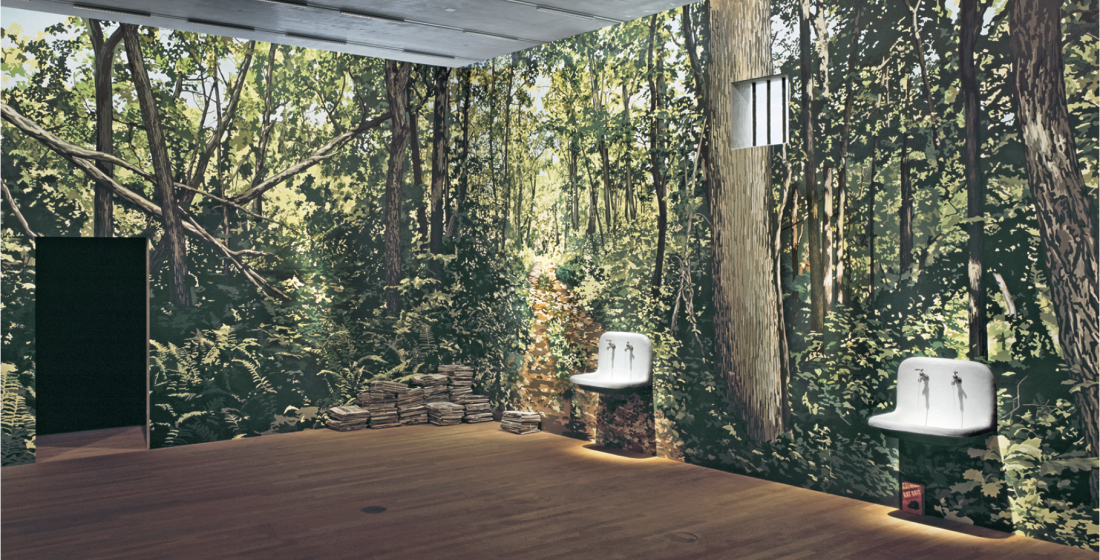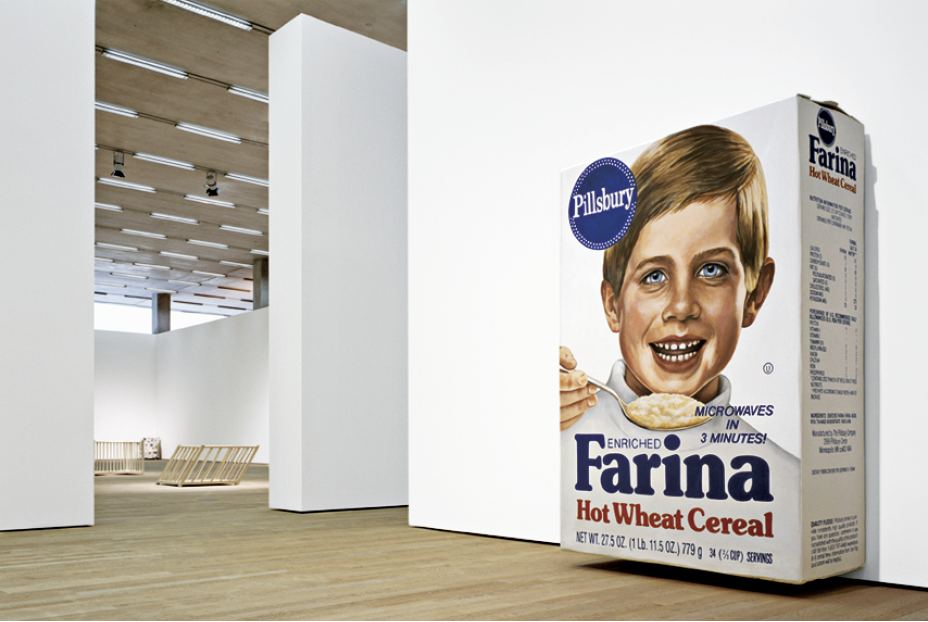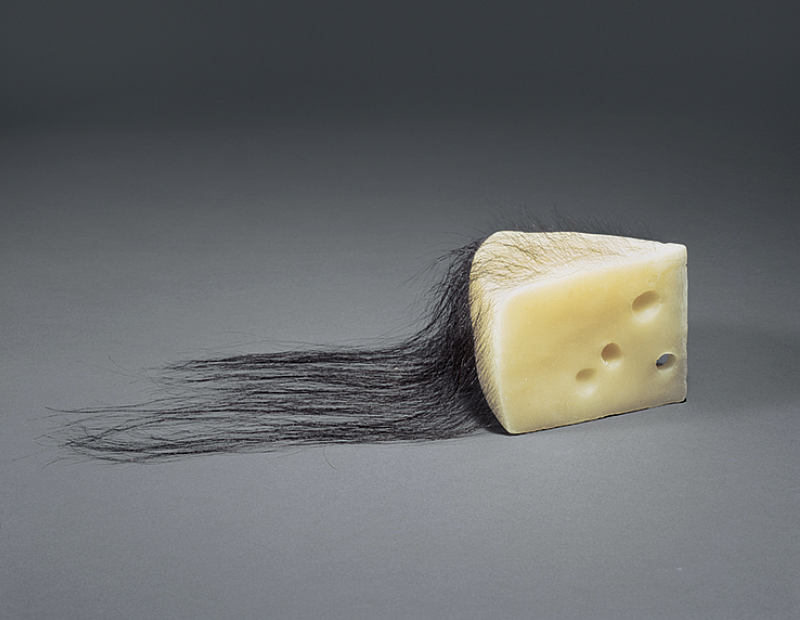Robert Gober
By Michael Fried’s standard “presentness is grace,” Robert Gober’s work has a grace that is subtly perverse. Presenting fabricated replicas of mass-produced, everyday objects and body parts in evasive tableaux, the artist’s work provokes a post-WYSIWYG visual rupture with mere “things.” What you see is not what you get.
I found myself surrounded by some 40 sculptures and five large-scale installations, and couples and trios and tour groups of nodding, satisfied citizens, mostly Europeans, quite pleased to uncover Gober’s valences in the heroically scaled and sealed Schaulager, in Basel, Switzerland. Gober’s dialect of analogous simulations is part of animated conversation today and I watched a team of insightful, lively North American children race ahead of me, pointing out the small deteriorations in each piece: “There’s a crack here!” and also the transepts where the work breaks with the expected: “This playpen is crooked!,” “Someone left the taps on!,” “There’s nothing behind those prison bars but a wall!”

Robert Gober, Untitled, 1992, mixed media, detail, 1300 x 920 x 450 cm. Installation view Schaulager, 2007. Collection of the artist. © Robert Gober. Photo: Tom Bisig.
An opening gallery included two doors installed symmetrically on opposite walls, each one gaping slightly to reveal a bathtub filling with water and a glimpse of a pair of pale legs. Gober makes the viewers peer. The kids peer. I peer. The parents peer politely. Necks crane to get a closer look, to draw more details from these unusual stagings that are defined by their formal simplicity, which belies the complexity of their fabrication.
Further on, moulded sink and urinal forms evoke pissing contests, functioning like trophies for puzzling rites of passage, cruising in public restrooms. These apparent near-commodities lie close to ready-mades in appearance, but not at all in structure, concern or labour. They are crafted from plaster, wood and metal. Importantly, some do not have fittings. There are no spigots, no drains, so they lack essential features that would normally define their function. In the place of fittings are gaping orifices, empty spots, holes.
Untitled, 1995–1997, is an especially strong example of Gober’s work, which includes a staircase flooded with rushing water that collects in a storm grate and drains into a basement chamber. A theatrically lit Madonna, coated to look like cast concrete, is the centrepiece of the room, her abdomen penetrated by a corrugated metal drainpipe. Symbolic gravitas: Mary’s abdomen as a passage—as a vessel—prepared to channel torrential rushing water. Two suitcases, normally containers used in passage but here passage itself, contain openings to the scene below. A subterranean tide pool seen through the suitcases teems with aquatic fauna and several coins painstakingly rendered by the artist at just above normal scale. The result is vertigo, where distance and situations become difficult to judge. I teeter at the edge. Within view, through the grate, are the legs of a man whom we see from above, dangling the legs of a child above the surface of the shallow water, which suddenly seems threatening, a risky depth into which this adult could plunge the child, at his whim.

Robert Gober, installation view, Untitled, 1993–1994, wood, vinyl, acrylic paint, 80 x 52 1/2 x 24”, Schaulager, 2007. Collection Ruth and Jacob Bloom, California.
Untitled, 1994–1995, is a fireplace holding a male torso giving birth to a child’s leg, throwing out of balance the biological role of men in conception. The piece underscores and questions physical distance as the normative contemporary qualifying feature of relations between adult males and children, while posing a situation where it is unclear whether the child is being consumed or expelled.
To reach another installation, I walked through a dark passage illuminated only by dim red lightbulbs. Bundles of discarded newspapers were stacked against the walls. Beyond this passage, where I felt I might have wandered into the museum’s storage facility, an architectural glade with paint-by-number trees on the walls appears at the point where the sound of running tap water drones on. Several sinks fill to the brim from taps left running. More risks.

Robert Gober, Untitled, 2005, beeswax, human hair, 5 5/8 x 6 5/16” (including hair), The Menit Collection, Houston.
Bent and twisted playpens are metaphors for disciplinary tools of socialization that isolate the child, containing and controlling deviant behavior. These objects evoke a generation raised before Growing Up Gay was required reading for guidance counsellors. These pieces, which are thickly coated with pigment the colour of milk that has turned, appear as an oblique reference to the minimalist cubic cages of Sol LeWitt. Gober’s stuff, too, comes out of a surreal tradition—think of a hairy piece of Swiss cheese—but he bends tradition toward ends suggestive and queer.
His practice can be defined by virtue of what it is not (via Rosalind Krauss’s tidy diagrams) and by celebrating how difficult his intention is to pin down. The litmus of whether these works strike awe seems outside concern critically, and clearly they are spectacular. In a room of Gober’s wallpaper, patterned with desperate sketches of genitals, for example, I’m genuinely shocked and moved when I see one kid pondering the selection, his face pensively locked, looking back towards Gober’s men’s wedding dress, absorbing it all with the calmest demeanour. Viewing Gober is much like watching an adolescent muddle through an elusive new understanding of sexuality; there isn’t much room for irony in that kind of space. It’s something too beautiful and awful. ■
“Robert Gober: Work 1976–2007” was exhibited at Schaulager, Basel, Switzerland, from May 12 to October 14, 2007.
Mark Clintberg is an artist, writer and independent curator based in Montreal.

